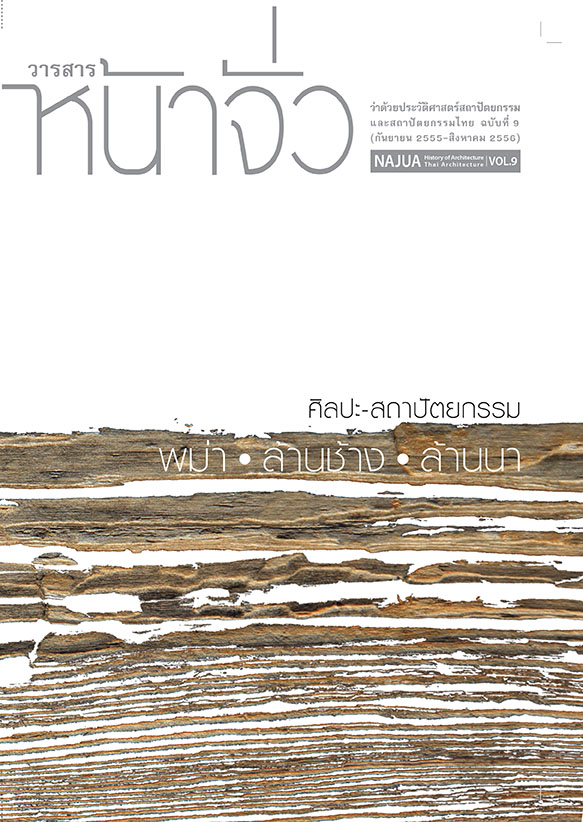ย้อนสำรวจ “ปรากฏการณ์ศาสตร์ในสถาปัตยกรรม” ทบทวนความเข้าใจในประเด็น “รากเหง้า-อัตลักษณ์” และ “หน่วยวิจัย” เชิงปรากฏการณ์ Re-engaging “Phenomenology in Architecture” rethinking the use of “Root-Identity” and “Units of Analysis”
Main Article Content
Abstract
บทคัดย่อ
การย้อนทบทวนสำรวจความเข้าใจในตัวทฤษฎีทางสถาปัตยกรรม เป็นสิ่งหนึ่งที่ก่อให้เกิดการขยายและต่อยอดองค์ความรู้ ซึ่งเป็นแนวทางการทำงานในเชิงวิพากษ์ของบทความชิ้นนี้ต่อแนวคิดทฤษฎี “ปรากฏการณ์วิทยา” ในศาสตร์สถาปัตยกรรม ไม่เพียงแต่เป็นเวลาเกือบ 20 ปีที่งานเขียนเชิงวิชาการชิ้นแรกของไทยในชื่อที่ว่า “ปรากฏการณ์ศาสตร์ในสถาปัตยกรรม” ได้ปรากฏขึ้นซึ่งเป็นการนำเอาแนวคิดทฤษฏีปรากฏการณ์วิทยาเข้ามาให้นักศึกษาสถาปัตยกรรมได้เรียนรู้ แต่เมื่อเวลาผ่านไป พบว่ากลับไม่ได้มีการขยายความ วิเคราะห์ ทบทวน หรือแม้แต่สานต่อความเข้าใจในความรู้ที่มี ดังนั้นสิ่งที่เกิดขึ้นไม่ว่าจะเป็นการยากต่อความเข้าใจในศัพท์วิชาการที่มีมากมาย เกิดความสับสน และซับซ้อนต่อแนวคิดปรากฏการณ์วิทยา ยังรวมไปถึงความคลาดเคลื่อนในการนำไปใช้ในการบันทึกและการถ่ายทอดข้อมูลต่างๆ ในขั้นของปฏิบัติการลงพื้นที่อีกด้วย ซึ่งมีความจำเป็นอย่างมากที่น่าจะทำการย้อนสำรวจเพื่อให้เข้าใจความสัมพันธ์เชื่อมต่อระหว่างศาสตร์ทั้งสอง
บทความชิ้นนี้ เป็นส่วนหนึ่งของงานวิจัยฉบับสมบูรณ์ “จากญาณวิทยาสู่กระบวนวิธีวิจัย : ศึกษาปรากฏการณ์วิทยาในสถาปัตยกรรม” ซึ่งมีข้อค้นพบจากรายงานฉบับสมบูรณ์ มีประเด็นหลักๆ 3 ประการที่ควรพิจารณา คือ 1) ปัญหาของความคลาดเคลื่อนในความเข้าใจที่ว่าด้วย “รากเหง้าและอัตลักษณ์” 2) ปัญหาความไม่ชัดเจนในความเข้าใจและการกำหนด “หน่วยวิจัย” เพื่อ “การวัดผลและการคลี่คลาย”ปรากฏการณ์ และ 3) ปัญหาในการทำความเข้าใจ กระบวนการคิด “การตีความ” ที่จะได้มาซึ่งความหมาย ซึ่งปัญหาหรือเงื่อนไขในการพิจารณาทั้งสามสามารถที่จะนำไปสู่การทบทวนกระบวนการคิดและการออกแบบงานสถาปัตยกรรมต่อไป อย่างไรก็ตามในบทความชิ้นนี้ จะทำการคลี่คลายในปัญหาหรือเงื่อนไขหลักที่สำคัญในข้อที่ 1 “รากเหง้า-อัตลักษณ์” เพราะเป็นประเด็นหลักพื้นฐานของปรากฏการณ์วิทยาที่จะต้องสร้างความเข้าใจในตัวเอง (ของผู้วิจัยและ/หรือผู้ออกแบบ) และการคลี่คลายจะนำไปสู่ประเด็นเรื่องความคลาดเคลื่อนในการทำความเข้าใจตัวเองกับการโหยหาอดีตซึ่งไปผูกติดยึดกับความเป็นไทย ดังที่เกิดขึ้นในปัจจุบัน และข้อที่ 2 “หน่วยวิจัย” เพราะเป็นจุดที่จะสามารถเชื่อมโยงผู้วิจัยเข้าสู่ บันทึก และถ่ายทอดปรากฏการณ์ และการคลี่คลายจะนำไปสู่ประเด็นเรื่อง “ท่าที” ของการใช้ หน่วยวิจัย และการวัดผลเชิงปรากฏการณ์
Abstract
One of various ways of expanding the body of knowledge in Architecture is to re-engage what has been written, deployed or thought of. This paper could be understood as a critical analysis to “Phenomenology” in architecture. Almost 20 years ago, “Phenomenology in Architecture” has been introduced to Thai academia. Since then it seems to be rare that this book, or in this paper regards it as a series, has been examined, analyzed, and re-engaged. It is not surprising that many people regards “Phenomenology” is something complicate, abstract and difficult to understand. When we tend to use it in the field work, it unfortunately shows some is understood, misused or even misinterpreted. Thus, there is a vital need for us, in terms of academic, to re-visit and re-engage with the body of knowledge derived from this series in order to make a better understanding of the intersection between Phenomenology and Architecture.
This paper is a part of the main architectural research titled “From Epistemology to Methodology : a Study of Phenomenology in Architecture”. The research found that there are three problems or conditions : 1) there is a trace of misconception of how architectural discourses use the notion of “root and identity”, that becomes problematic and it must be unpacked in order to advance the “self-understanding” process, 2) the way of defining and using the “unit of analysis“ in architectural discourses is unclear, and 3) the way in which the “meaning” can possibly be interpreted needs to discuss theoretically. This research also believes that by exploring through these three problem or conditions it can lead to a better understanding of architectural design methods as well. However, this paper is focused solely on the first two problems. For the first problem, it can lead us to unpack the notion of “root and identity”, which seems to be overwhelmingly dominated Thai architectural discourses. For the problem of “units of analysis”, it helps us to have a better understanding of how to experience the phenomenon. Through the way of examining this particular problem, it leads us to rethink of our standing point, our attitude, and ways of perceiving space phenomenologically.

